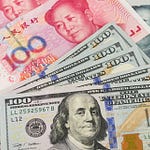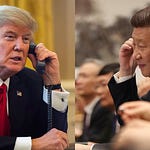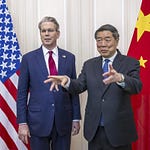Episode Overview
In this enlightening episode, we delve into the heart of China's manufacturing industry with Mu’s UVA alumni and industry expert Shaojian Zhang (His Linkedin). With a rich background spanning 30 years in various sectors including industrial technology and manufacturing in China, Singapore, and the US, Shaojian offers a comprehensive view of the evolution, current state, and future prospects of Chinese manufacturing.
Key Highlights
Introduction and Background
Shaojian Zhang introduces his extensive background (Haier, Rockwell, GE, CITIC) in the industrial and technology sectors, highlighting his experiences across different global markets.
Defining High-End Manufacturing
High-end manufacturing is characterized by both the type of products and the advanced processes used in manufacturing, including robotics and data science techniques.
Evolution of China's Manufacturing Industry
The development of China's advanced manufacturing started around 2000.
The industry's evolution is split into two key decades: 2000-2010 focused on absorbing foreign technology, and 2010-2020 saw growth in industrial automation and other advanced fields.
Role of Foreign Firms and Learning Process
Early involvement of foreign companies like Siemens and GE in joint ventures.
The learning process was market-driven, focusing on collaboration, customer feedback, and continuous innovation.
Factors Behind Rapid Advancement
China's large market, engineering talent pool, leading manufacturing supply chain, and significant capital availability.
Government support in education and resource allocation played a crucial role.
China's Global Manufacturing Leadership
Leading in sectors like EVs, batteries, robotics, and 3D printing.
The "going global" strategy is driven by market proximity needs and supply chain considerations.
Current State and Future Outlook
Discussion on consumer confidence impacts, government policies, and the effects of chip sanctions on non-AI industries.
Advice for global investors and businesses to utilize China's capabilities and resources effectively.
Additional Materials:
Full transcript
(The transcript has been edited for better reading experience)
[00:00:00] Mu: Welcome, Shaojian. Can you introduce yourself first?
[00:00:02] Shaojian: Thank you, Mu, for this opportunity to have a dialogue on China's economy, particularly on the technology and the industry side. My name is Shaojian Zhang, and I'm a Darden alumnus from 1999. My background is primarily in the industrial and technology sectors, including the manufacturing industry. I have been in this business in China, Singapore, and the US for 30 years. I have experience in the supply side, manufacturing, consulting, and the investment field as well.
[00:00:44] Mu: Yeah, so we've known each other for many years, and I know you have had a very accomplished career. You worked as a senior executive at a leading US manufacturing firm and now you are focused on investment in China, mostly in China-based manufacturers, particularly in high-end manufacturing. You're also an advisor for some of the leading-edge manufacturing technology firms. So, in terms of investment in manufacturing or Industry 4.0, can you define what high-end manufacturers are?
[00:01:18] Shaojian: High-end manufacturers are characterized by two important aspects. First, it refers to the type of products they manufacture. Second, it includes how they manufacture those products. This encompasses the manufacturing process, including the use of advanced manufacturing equipment such as robotics and the application of advanced data science techniques.
[00:01:51] Mu: You have spent decades working with different industrial companies and projects in China, witnessing the evolution of China's manufacturing industry. Can you give us an overview of the stages of development in China's manufacturing industry after the reform?
[00:02:11] Shaojian: Yes, it has been a long-term evolution for China's manufacturing industry. The development of advanced manufacturing in China started around 2000, when many indigenous, joint-venture, and foreign investment companies began manufacturing high-end products. This period marked a turning point when the Chinese industry became more sophisticated.
[00:02:49] Mu: So, after 2000, China started to become more sophisticated in the manufacturing industry. Can you describe the beginning and what you have observed in recent years?
[00:02:59] Shaojian: We can divide it into two stages, each lasting around 10 years. From 2000 to 2010 and from 2010 to 2020, these two stages were quite different for China's manufacturing industry. In the first few years, the industry started absorbing advanced technology and manufacturing techniques from overseas companies. By 2005, the products being produced gradually became competitive with those from other countries. By 2010, a critical point was reached when China's electricity consumption matched that of the United States. This was a significant turning point. For instance, in industrial automation, the use of precise motion control and robotics in manufacturing saw rapid growth in China by 2010 compared to the previous decade.
[00:04:37] Mu: You mentioned that initially, it was more about foreign firms coming into China and Chinese companies absorbing their technologies. What was the role of foreign firms then, and how has it changed?
[00:04:49] Shaojian: Initially, foreign companies like Siemens, GE, Schneider, and Japanese companies would establish sales offices or joint ventures with Chinese companies. Gradually, Chinese companies learned how to manufacture these products and gained an understanding of the technologies involved. For example, in the home appliance industry, they started by building OEM products for overseas customers.
If we look at the home appliance industry today, it has progressed far beyond that initial phase. Companies like Gree, Haier, and Midea are now among the top five worldwide. They design their own high-end products and offer a wide range of options. Chinese manufacturers are at an advanced stage in this particular industry.
[00:06:37] Mu: There have been different narratives about China's catching up, ranging from "intellectual property theft" to "forced technology transfer" or more friendly ways like "learning," "joint ventures," and "collaboration." What exactly happened during that period when Chinese firms were catching up or learning from Western firms?
[00:07:07] Shaojian: This is a sensitive topic, and different people have different experiences and conclusions based on the information available to them. From my participation in both sides of the business, I consider it a market-driven process. When you want to sell products and localize your operations, you have to work with suppliers and share certain information with them. Gradually, they understand how to do it, not necessarily by directly copying your product, but through exposure and knowledge overflow. This is a normal way for knowledge and insights to spread in a market. Additionally, when advanced products are sold in a certain market, users gain better experience and knowledge, which can be accessed by manufacturers to develop new products based on customer feedback. It is important to note that knowledge and intellectual property should be considered evolving rather than static. As long as companies continue to innovate, copying previous generations of products should not be a major concern. However, there are instances of companies copying other Chinese companies, which is a more generic problem.
[00:09:12] Mu: So, it is more about market dynamics and competition that drive manufacturers to continually improve their products.
[00:09:21] Shaojian: Yes, the competition and market dynamics heavily influence the continual improvement of products.
[00:09:30] Mu: Then the question arises, why have Chinese manufacturers caught up faster compared to other less-developed countries that are also trying to catch up?
[00:09:48] Shaojian: China has been the most rapidly advancing country in terms of product innovation for several reasons. Firstly, China has a huge market, attracting companies from around the world to participate. This exposure to different technologies and knowledge enables faster innovation and more extensive learning. Secondly, China has a large pool of engineering talent, which is critical for new product development. Thirdly, China has a leading manufacturing supply chain, known for its speed and efficiency. Additionally, in the past 20 years, China has had significant capital supply, so access to funding has not been an issue.
[00:11:12] Mu: The three reasons you mentioned are having a large market, a large engineering talent pool, and a leading manufacturing supply chain. The growth of China's manufacturing industry has been supported by these factors, as well as government policies that have nurtured different parts of the supply chain ecosystem.
[00:11:46] Shaojian: Yes, to some extent. Let's take the power distribution equipment business as an example. Initially, state-controlled design institutes opened up to foreign companies and encouraged collaborations with local manufacturers. This opened up the market and facilitated knowledge transfer. Additionally, the government has supported education in relevant fields, with many universities offering courses and degrees related to manufacturing. Furthermore, the government provided financial and resource support to foster the growth of the industry.
[00:12:42] Mu: It's fascinating to think about how China has developed the most complete supply chain across 200 sectors. Now that China has caught up with global manufacturing standards, what industries is China leading in?
[00:13:08] Shaojian: Yeah. That's how a lot of them. Today, people are talking about foreign companies like Volkswagen working with Chinese companies in EV and EV battery. And not only working with Chinese companies in China. They actually bring Chinese technology or products back to the US and Europe. There have been many high-profile cases, well, I think I don't need to mention. So certainly in these two areas, China is leading worldwide. And even in the robotic side, China is making quite a huge progress on industrial robots, as well as some collaborative robots. And 2-3 years ago, people were talking about humanoid robots, and that's where we are still doing very well.
[00:13:57] There are probably three categories of areas where Chinese companies are doing very well. One is in some of the industries that have migrated from the US or Europe to Asia in the past 20 and 30 years. So China keeps innovating in those areas. Right now, they are the leading country in those areas, like some materials and fibers, just to name one category. The second category is, of course, home appliances and some small consumer electronics products. Chinese companies are doing very well in those products. And the third one is probably a lot of the industry components, like electro-mechanical devices. China has been doing very well.
[00:14:52] Mu: Anything that you think from a Westerner's perspective is unknown but is very advanced in China?
[00:14:59] Shaojian: One of them I can think of is 3D printing. China has been doing very, very well. In Europe, you have Siemens and a couple of companies doing very well. In the US, of course, GE has been doing very well. But China has been a huge force in the 3D area.
[00:15:19] Mu: That's both consumer 3D printing and industrial 3D printing, right?
[00:15:24] Shaojian: Yeah. Those plastics are used for home toys or medical applications, but also for high-end titanium materials and engine parts, for those drone components.
[00:15:37] Mu: Got it. Now that Chinese companies and manufacturers have built a lot of advanced manufacturing capacity, we are also hearing a theme of "going global". We know that part of it is due to the changing trade policy globally. Right. There are some hurdles for Chinese manufacturers to export their products directly. But other than that, what kind of overseas strategy have you seen?
[00:16:02] Shaojian: There are quite a few reasons. What you mentioned is one important factor to consider why you have to go overseas to set up not only a business channel for sales but also probably a production capability overseas. The second one is really about some industries needing to be close to the market. Yes, you need to constantly work with your customer. Your application engineers need to work with their designers. So in that case, having a sales channel is not sufficient. You need to be co-located in the same city. This is a very important factor for a lot of industries, particularly when you are talking about advanced manufacturing. So this is obviously the second one. The third one is really for supply chain considerations; some products are not meant to travel long distances. I was talking to you a moment ago about 3D printing; for 3D printing, the material powder, the powder, is very heavy. So if you produce powder in China and move it to the US or Europe, that's not going to make the business case. So you have to set up the factory in Europe or the US to supply these powders directly to your customer base.
[00:17:30] Mu: Percentage-wise, how many of the manufacturers you've seen are considering going overseas? Is there a broader trend?
[00:17:36] Shaojian: It's a widespread phenomenon right now. And most of the people I met, when they grow their business to maybe just a hundred million RMB, start to consider what to do. Initially, they set up some sales channels. Gradually, they need to consider whether they need to set up an office in another country and then manufacturing capabilities as well.
[00:18:03] Mu: At a very high level, I think it makes sense. We are seeing high inflation in many countries. That speaks to a shortage of supply. Definitely. And then China itself has a low inflation rate. And we have a lot of abundant capability as a supply. So at a very high level, if China's oversupply can be used to address the shortage of supply in the inflationary countries, then both sites will benefit. I'm quite positive about this thesis. We just need to let the countries and all these trade organizations sort out how to play that, given the current political dynamics. But, what's your view?
[00:18:42] Shaojian: Yes, certainly, I think when you listen to what Musk was talking about, he always talks about in China, how people are diligently working, growing businesses, and starting businesses. That's one important factor because we have so many businessmen and entrepreneurs who want to do something. So you almost have an oversupply in capability. That's a very culturally important effect. And in some other countries, you might not have this kind of phenomenon. So that's number one. And number two, that entrepreneurial spirit, really, if given a chance, can also play an important role in our country. That's what I was talking about. Not just exporting goods to other countries. They go to other countries, work with local people, like doing some JV. So it's like many years ago, when multinational companies from Hong Kong and Southeast Asia, Chinese came to China, doing business in China. Not only were they making money, but they also benefited local development. Now, it's time for Chinese companies and businesses to go to other countries, do JV, do business, make some money, and help the local economy.
[00:20:00] Mu: That's the, I would say, the hopeful prospect of integrating with the local economy and helping them build it. There are many hurdles that these global Chinese entrepreneurs have to overcome before doing that. So let's switch to a more sensitive one. I've been tracking the development of consumer markets and internet markets in China, as well as the financial markets. Overall, it's not been recovering as fast as I expected, went through some setbacks during the COVID years. What have you seen for China's manufacturers in the last few years? Is it the same direction that we see in the consumer market or is it different?
[00:20:41] Shaojian: Yes. Obviously, consumer confidence or sentiment will reflect on the B2B manufacturing, so that's been a huge issue for quite some time. I guess for a lot of manufacturing companies, they probably still need a little bit of time to digest the current situation and probably need some time to figure out what to do, whether they can have a better year for 2024, making some big investments, or starting some new business. Or do more international business as well. So that's a few things people are considering, but it needs some time.
[00:21:26] Mu: But we see that the government is shifting its policy towards encouraging advanced manufacturing, right? Even more so since last year. How has that shift boosted morale and the growth of these sectors? Do you see the impact of that? I thought that would offset some of the performance in the consumer end.
[00:21:49] Shaojian: Yes, for certain segments, if it's under government policy which encourages them to develop faster, make more investment, certainly people are putting more effort, particularly in the early stages of research and development, new product development. Those areas, certainly you can see, like 3D printing, some advanced robotics. Yeah. And a lot of new energy industries, like lithium batteries, solid-state batteries, and semi-solid batteries. In those areas, you can see a lot of startup companies and large companies making innovations. Certainly, that has been very strong. But other than that, for the business to grow and still depends on the whole market recovery otherwise those innovations are not going to bring a lot of revenue for the current year. So those are really future.
[00:22:52] Mu: So the government's policy is more on fostering investment in the short term, not keeping them alive and keeping the confidence.
[00:23:00] Shaojian: Or create demand for the product, which really should come from the consumer market and flow over to the B2B market.
[00:23:07] Mu: So that's the internal constraint. We'll talk about another highly debated question: chip sanctions, right? We don't have to talk about how China should react, but in advanced manufacturing, chips matter. Right? You need a lot of chips for automation. So were the chip sanctions, the CHIPS Act, creating challenges for the non-AI industry?
[00:23:28] Shaojian: This has been an interesting discussion. Actually, there was a worldwide shortage of semiconductor products which in 2018 was not really because of political issues. Just global short-supply. So in that period, the whole advanced manufacturing industry was hit hard. And they are talking about some PLCs controllers, for the robotics, for the industrial equipment. You needed six months or seven months of lead time. So it was a huge issue for China in 2018. But talking about the semiconductor and shortage because of geopolitical considerations, most of the industry controllers or semiconductors are not so advanced. You don't need that GPU to do normal PLC control. So it's not that bad.
[00:24:25] Mu: This is a great overview of the evolution of China's manufacturing sector. You have worked with both global firms and local firms. What would be your advice to global investors and global businesses that are looking into investing in and doing business in China's manufacturing sectors going forward?
[00:24:48] Shaojian: Yes, I think a lot of medium-sized and large multinational companies have been benefiting from doing business in China in a lot of aspects. They can continue or should continue working in China, developing new products, leveraging China's capability, supply chain, and engineering. Also, advanced technology. And because you have exposure to worldwide technology in China. So if you're only from Europe or one country, there's no better place to have access to technology from worldwide. So that's number one. Number two is it's a good place to do new product introductions because of the supply chain and as well. The third one is really a totally new area. It's working with Chinese companies in other countries. And also home countries as well, this is a new challenge and a new opportunity.
[00:25:53] But for smaller companies and also maybe some companies from Southeast Asia, Latin America, or Africa, it's really about how to play the China card, because China has so much resource. It's like your backyard. How to leverage this resource to make your product and business competitive. It's so obvious a card whether you like to play or not. So I was in Singapore, a couple of months ago, I was talking to quite a few people locally, and they are thinking about leveraging China's resources, building a JV business in Singapore, or maybe a factory in Malaysia, Thailand, or Indonesia.
[00:26:40] Mu: We are experiencing an inflection point in terms of how we perceive and work with China's manufacturing industry. It has grown to a level where you can climb up the supply chain and create more value, both domestically and globally. On the China side, I think the Chinese government and the Chinese companies are also trying to figure out how to deal with this new reality. Global investors and global businesses also have to learn about this new reality and how to take advantage of it. This is a very interesting period. And thanks, Shaojian, for sharing your insights.
[00:27:20] Shaojian: Nice talking to you. I appreciate the opportunity. Thank you, Mu.












